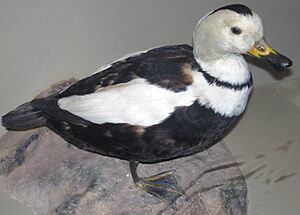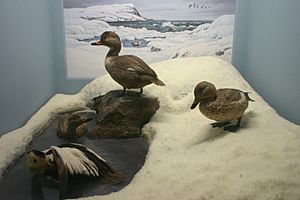Labrador duck facts for kids
Quick facts for kids Labrador duck |
|
|---|---|
 |
|
| Female specimen, Smithsonian National Museum of Natural History | |
 |
|
| Male, Field Museum of Natural History | |
| Conservation status | |
| Scientific classification | |
| Genus: |
Camptorhynchus
|
| Species: |
labradorius
|
 |
|
The Labrador duck (Camptorhynchus labradorius) was a type of duck from North America that is now extinct. It was the first known bird species unique to North America to disappear after Europeans arrived. The last time anyone saw a Labrador duck was in 1878 in Elmira, New York.
Even before European settlers came, this duck was quite rare. Because it was so rare, we don't have a lot of information about it. However, we do know some things, like where it lived, what it looked like, what it ate, and why it became extinct. Today, there are 55 Labrador duck specimens kept in museums around the world.
Contents
What Was the Labrador Duck?
The Labrador duck was a type of sea duck. It was also known by other names like "pied duck" or "skunk duck." These names came from the male duck's striking black and white colors, which looked a bit like a skunk. It was also called the "sand shoal duck" because it liked to find food in shallow waters. Scientists believe its closest relatives were the scoters, another group of sea ducks.
What Did It Look Like?
Female Labrador ducks had grey feathers. Male ducks were black and white, with mostly white wings. The Labrador duck had a long, oval-shaped head with small, dark eyes. Its bill was almost as long as its head. Its body was short and flat, with strong feet placed far back on its body. It had small feathers and a short, rounded tail. The Labrador duck was the only species in its group, meaning it was a unique kind of duck.
Where Did It Live?
The Labrador duck traveled each year. In winter, it lived off the coasts of New Jersey and New England in the eastern United States. It preferred sandy coasts, calm bays, harbors, and inlets. In the summer, it moved north to Labrador and northern Quebec to breed.
Some people believe it laid its eggs on islands in the Gulf of Saint Lawrence. However, not much is known about how the Labrador duck reproduced or raised its young.
What Did It Eat?

The Labrador duck mainly ate small molluscs, like mussels. Fishermen sometimes even caught them on fishing lines baited with mussels. The duck's bill was special. It had a wide, flat tip with many small ridges inside. This design helped it find food. Its bill was also very soft, which might have helped it dig through mud or sand to find hidden food.
Scientists think the Labrador duck's diet was similar to the Steller's eider, another duck found in the North Pacific and North Asia. Its unique bill suggests it was very good at finding shellfish and crustaceans in shallow, muddy waters. It might have even survived by eating snails.
Why Did It Disappear?

The Labrador duck was always rare, but its numbers dropped even more between 1850 and 1870. Its extinction, which happened sometime after 1878, is still a bit of a mystery.
Even though people hunted these ducks for food, they were not very popular. Their meat was said to taste bad, spoiled quickly, and didn't sell for much money. So, hunters didn't go after them very often. However, there are a few ideas about why they disappeared:
- Overharvesting of eggs: People might have collected too many of their eggs.
- Feather trade: The feather trade might have harmed them in their breeding areas.
- Food shortage: The growth of towns and industries along the Eastern Seaboard led to a decline in mussels and other shellfish. These were the main foods for the Labrador duck in winter. While other sea ducks also eat shellfish, the Labrador duck seemed to rely on them more than any other bird in the Western Atlantic.
- Habitat changes: A big increase in human activity along the North American coasts might have forced these ducks out of their usual homes. It was hard for them to find new places to live because their range was only along the American coast of the North Atlantic.
Whatever the exact reasons, the Labrador duck sadly became extinct in the late 1800s.
Images for kids
See also
 In Spanish: Pato del Labrador para niños
In Spanish: Pato del Labrador para niños





